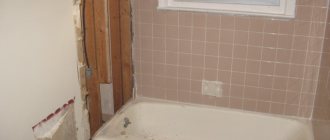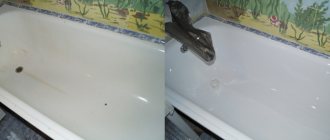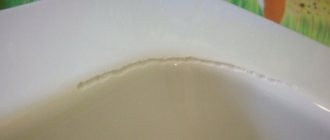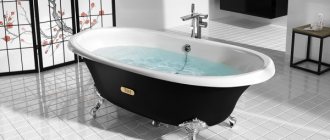Every housewife would like to see her bathtub snow-white, but sometimes a yellow coating cannot be avoided upon contact with water. In addition, various fungi and molds like to multiply in a humid environment, which already poses a threat to health.
There are many options for how to clean a bathtub from yellow deposits and other contaminants. When choosing a method, you should take into account the material from which the bath is made and the available products.
Main types of pollution
The bathtub has to be washed from various contaminants, and in order to choose the right product, you need to find out the reason. Standard bathroom stains:
- Soap scum. Shampoo, soap, shower gels, etc. are used every day. If you do not wash the bathtub thoroughly after each use, a barely noticeable film appears, which layers over and over again and turns into an unsightly coating. The film from household chemicals eats into the walls and cannot be removed without detergents.
- Lime deposits. It appears on plumbing fixtures upon contact with hard water.
- Rust. Red streaks on the bathtub will appear if there is a high concentration of iron in the water.
- Yellowness. It is caused by water flowing through old communications that can no longer be washed.
- Mold. Black spots of fungus are not only unpleasant in appearance, but also dangerous to health. They appear in the seams between the bathtub and the wall, on slopes and in other places with high humidity. It is imperative to get rid of mold, as its spores penetrate the human respiratory tract.
- Colored spots. The reason for this is careless handling of dyes: hair dye, brilliant green, potassium permanganate, etc.
- Traces of repairs. When carrying out cosmetic or major bathroom renovations, it is important to protect the plumbing. It is difficult to clean a bathtub from traces of repair.
If you want to clean your bathtub white, you should inspect it carefully. If there are cracks on the surface, then it will not be possible to completely remove the stains, and they will appear again. In cracks, contaminants accumulate and are retained. But it’s quite possible to remove yellowness and brighten the bathroom using folk methods.
How to remove rust
You can remove rust from a bath using the following methods:
- Ammonia. It needs to be applied to the bathroom for a couple of minutes, then rinsed with water. Ammonia has a pungent odor, so it is better not to close the bathroom door during treatment.
- Lemon juice. Used similarly to the previous product. Lemon juice can also be mixed with borax - this mixture will add shine to the bathroom.
- A solution of vinegar and salt. Sprinkle salt on the stain, pour vinegar over it, leave for 20 minutes, then remove with a soft cloth.
- Oxalic acid. It can be used to clean the bathtub from rusty stains. Dissolve the product in water in a 1:1 ratio and spread on the stain, leave for 20 minutes, rinse.
- Traces of rust are washed off with water, peroxide and alcohol. The last 2 components are mixed in a 2:1 ratio, applied to the stain using a sponge, leave for 15 minutes. Next, rinse with water.
Another effective cleaning solution is a mixture of soda ash and baking soda.
- Mix soda ash and baking soda in a 1:1 ratio.
- Add enough water to the baking soda mixture to obtain a porridge-like consistency, stir until smooth.
- Apply an even layer over the surface of the rust stain.
- Mix regular vinegar and powdered bleach. Proportion 1:1. Apply to a layer of baking soda.
- Leave it on for 30 minutes, then rinse off.
Important! You should not scrub off rust with a metal brush; regardless of the material from which the bathtub is made, its coating will be damaged.
Why does acrylic turn yellow? — “Acryl-MSK” | Moscow
Answering the question: “Why does acrylic turn yellow?”, let us clarify what exactly we mean by “acrylic.” Firstly, acrylic - the material from which bathtubs are now made - is a polymer plastic with good thermal insulation properties. Secondly, acrylic is a type of epoxy enamel with a polymer base, it is used for the restoration of bathtubs. Bathroom restoration should be understood as:
- the process of applying a new coating to an object (bath);
- applying an acrylic coating over the old (factory enamel);
- renewal, restoration, replacement of the acrylic coating that was previously poured.
An important point is that bathtubs made of acrylic plastic can also be restored, however, experienced craftsmen advise carrying out this operation only in cases where the object has become significantly worn out. There are no guarantees of successful restoration of such products; there is only one piece of advice - buy a new bathtub. And one more thing - acrylic for restoration and the material from which bathtubs are made may differ from each other and have different properties.
Now let's look at the reasons that could cause the acrylic surface of bathtubs to turn yellow.
Rusty water
Rusty bath water
The most common cause of yellowing of acrylic and enamel bathtub surfaces is bad water from the mixer; it contains iron, which, when oxidized, gives a characteristic “yellow color” ranging from light yellow to rich brown.
Most often, rust appears in water due to poor water pipes that have worn out during use. Another reason may lie in the mixer.
It happens that parts of the mixer, for example, a cartridge, contain iron components - this feature usually affects cheap, uncertified products.
How to deal with yellow discoloration caused by water with high iron levels? Such yellowness can be easily removed with the help of cleaning products, the specifics of which we will discuss in the next part of the article. But there is an important nuance - pollution will be repeated all the time.
Therefore, the cardinal solution to fix the problem is to replace the pipes and install a filter. The first is recommended for those cases when replacement is carried out at the level of the entire riser, the second - when such a replacement cannot be made for some reason.
The filter can also be installed after replacing the pipes - this precaution will not be superfluous, it will eliminate the need to think about the quality of water in the future.
Improper bathtub cleaning
Trying to remove yellow stains from rusty water can end disastrously for acrylic material - it may turn yellow forever. Yellowness caused by chemicals cannot be eliminated.
A passion for cleanliness is a great quality, but cleaning acrylic or acrylic enamel bathtubs must be done with caution. Products containing citric, oxalic or acetic acid are not suitable for bleaching acrylic surfaces. Acrylic cannot be cleaned with gasoline, acetone and solvent 646. For cleaning, you should use products based on active oxygen and chlorine. Experts recommend regular baking soda.
How to fix a problem if it has already formed? Plastic bathtubs are usually replaced. The acrylic enamel of cast iron and steel bathtubs will need to be restored using liquid acrylic or enamel. All this requires additional costs, so it is better to avoid such problems with improper cleaning.
Product defects, counterfeits and other quality issues
An acrylic bathtub should be purchased from large retail chains. Products must have a guarantee and a quality certificate. Defective or uncertified products have one characteristic feature - low price. The cost of low-quality acrylic bathtubs is half the cost of good products. They are sold in markets, in small shops and by hand through advertisements. You need to think carefully before buying - the stingy pays twice!
Acrylic enamel also has features related to its quality. The most common brand of this product is “Stacryl Ecolor”. This acrylic is a pioneer in the field of acrylic materials for bathtub restoration. Early samples of these products tended to turn yellow over time. The problem has now been resolved.
However, the old formula was available to some manufacturers operating on an unofficial basis. They flood the market with fakes that suffer from the shortcomings of the old “glass.” There are fakes not only of glass, but also of other manufacturers.
It happens that artisans select the acrylic enamel formula “by eye,” which has a corresponding effect on the product, so it is important to buy the product in specialized stores.
Lime deposits
Use soda and vinegar to remove limescale from the bathtub. Order:
- Mix baking soda and soda ash, take them in equal parts.
- When dry, sprinkle on plaque. Leave for 30 minutes.
- Rub lightly, a light abrasive will remove plaque. Then wash off.
Vinegar is used like this:
- Soak paper napkins in vinegar.
- Cover areas with deposits with napkins.
- Leave to act for 5 hours.
- After the allotted time, remove the napkins and rinse with plenty of hot water.
Lemon juice can remove yellowness from a bathtub. For one-time cleaning you will need 100 g. Dilute the juice with 2 tbsp. water, apply the solution to the dirt. Repeat the procedure for 2 hours at intervals of 15 minutes. Next, carefully rinse off any remaining residue with water. Cleaning should be done with rubber gloves, as lemon juice can damage the skin of your hands.
Stubborn old stains can be removed with ammonia and peroxide. It is necessary to mix 2 parts of ammonia and 1 part of peroxide. Apply the resulting liquid to the stain and leave for 15 minutes. Afterwards, rub the treated areas with a sponge and rinse off the surface. If the stains were not removed the first time, repeat the procedure.
Using household chemicals to remove yellow stains will be a quick solution to the problem, but you should carefully read the manufacturer’s recommendations and choose the product that suits the material of your bathroom. Bathroom tiles can also be cleaned of plaque using folk remedies.
Bonus - cleaning the bathtub from mold
It is always useful to know not only how to clean a bathtub from yellow plaque at home using folk remedies, but also how to deal with the unfortunate mold in the plumbing room. There is one simple secret - tea tree oil. It needs to be added to water (2 tsp of oil per 500 ml) and sprayed from a spray bottle on the areas where mold accumulates. After 2-3 hours, all that remains is to wipe the treated areas with a cloth and throw it away. The flower quickly dies from the fragrant oil.
Mold
Black spots of fungus must be removed. Both traditional methods and household chemicals will help:
- Coal. Grind the tablets and mix with liquid bleach until a porridge-like consistency is obtained. Distribute the resulting product over the stain, leave for 1 hour and rinse.
- Soda and vinegar. To clean, sprinkle baking soda in a thick, even layer over areas with mold, then pour in vinegar and leave until the reaction is complete.
- Mold stains can be washed off with laundry soap, but this must be done regularly.
- Copper sulfate. It is dissolved in water and applied with a brush to areas with mold. This must be done with gloves.
- To clean the bathtub, household chemicals are used. A simple option is bleach or chlorine. Apply the product to the affected areas and leave for 15 minutes, then rinse with water.
Precautionary measures
Whatever you use to clean your bathtub, be careful. Wear protective gloves and avoid contact with eyes. If contact does occur, thoroughly rinse the damaged area with water and consult a doctor.
The more often you clean your plumbing, the easier it will be.
The yellowness in the bathtub looks terrible. Cleaning it periodically will help maintain its snow-white appearance. This can be done by any convenient means. For example, using household chemicals or folk remedies. It is important to choose exactly the one that is suitable for your bath. Otherwise, you may not only not clean it, but even damage it.
Acrylic bathtub
You need to carefully wash the acrylic bathtub from plaque, since acrylic is a very fragile material. Basic care is regular rinsing with warm water, this should be done after each use. Use only soft sponges and special cleaning products. You can remove accumulated dirt with a weak solution of washing powder. To clean bathtubs with acrylic coating, it is prohibited to use:
- Alkaline and acidic compounds.
- Solutions containing alcohol.
- Abrasives: powders, hard scourers, etc.
- Bleach with chlorine.
Advice! For general cleaning, purchase a special cleaning agent for acrylic in the form of a gel, cream or foam.
Enamel bath
The enameled steel bathtub is highly wear-resistant and easy to clean. In this case, you cannot use products containing acid and chlorine; under their influence, the enamel will turn yellow.
If a yellow coating appears, you cannot use abrasives, since the enamel layer is quite thin and can be easily damaged.
- A mixture of baking soda and water will help remove rust. Apply it to the stain and leave for 40 minutes, then wash off.
- Soda ash mixed with baking soda will help make the surface white. Removing stains and disinfecting can be done with mustard. Apply the powder for 20-30 minutes, then rinse with water.
- Salt and wine vinegar will help get rid of old stains. You need to take 1 tbsp of salt. l. and add it to 100 ml of vinegar. Afterwards, put the mixture on the stove and heat it to a temperature of 60 degrees. Next, apply the mixture to the stain and leave for 20 minutes.
- You can remove yellowness and limescale using citric acid. Dissolve 2 tbsp in a glass of water. l. lemons and apply to problem areas using a sponge or spray bottle. After 15 minutes, wipe the stains again with a sponge soaked in the solution and rinse with water.
- Cleaning powder paste. For the product you need: peroxide 60 ml, any cleaning powder (soft) 300 g, cream of tartar crystals 5 g. Mix the components and treat the contamination. Excellent fight against rust.
Cast iron bath
If you want to clean your cast iron bathtub white, it is important to know what substances you should not use. Prohibited:
- Petrol
- Washing powder
- Chlorine
- Strong acids
- Abrasive pastes
- Metal, fiberglass sponges
Advice! Cleaning agents for heavy stains can be white spirit or acetone.
Allowed to use:
- Soda ash, baking soda.
- Vinegar and lemon juice or acid. These components should not be applied more than once a week.
- Ammonia.
The methods for using all these tools are described above.
How to clean an old cast iron bathtub
It is possible to wash an old cast-iron bathtub, but over time you will have to fight with more radical means. The most common problem with old cast iron bathtubs is yellow stains. They appear as a result of the reaction of water with zirconium salts, which are found in old baths.
Vinegar essence will help remove yellowness from a very dirty bathtub. How to use:
- Fill a bath full of warm water.
- Pour in 1 glass of vinegar essence.
- Leave for 4 hours, then drain the water and rinse the bathtub with water.
It is better not to use bleach to remove stains from cast iron bathtubs ; instead, we will offer several more cleaning options:
- Mix baking soda with liquid soap until a homogeneous paste is obtained. Rub on traces of rust, stains, leave for 20 minutes, then rinse.
- Ammonia and any liquid soap. You need 1 tbsp of ammonia. l, liquid soap 0.5 tbsp. Combine the components and apply the resulting solution to the stain. Leave for 15 minutes, rub thoroughly with a soft sponge, rinse. After such cleaning, the bath will shine again.
What cleaning products should you avoid?
- From abrasive cleaners, since the solid particles contained in these cleaners can lead to scratches on the surface being cleaned;
- From hard brushes, sponges with metal coating. As a result of working with them, the walls of the font become covered with small cracks, and the material is corroded.
- From those containing chlorine (this is why the bottom of the tank often turns yellow, because some housewives think that it will be cleaner), acids, ammonia, acetone, gasoline. Interaction with these drugs will lead to darkening and dullness.
Tip No. 3. Do not use powdered products, as they can damage the integrity of the coating; avoid harsh chemicals.
How to clean a bathtub after renovation
During renovation, it is important to protect the bathroom with film from the ingress of construction mixtures and paint. It is quite difficult to clean the bathroom from these substances without damaging the surface. Try to remove stains while they are fresh.
Important Recommendations:
- To remove streaks of paint or sealant, use a solvent: acetone or white spirit.
- If the silicone, paint or mortar has already dried, then the first stage of removal is mechanical cleaning. To do this, use a razor blade, which carefully cuts off ball by ball, without touching the surface of the bathtub. After this, a cloth soaked in a solvent is applied to the stain. You need to leave it for 15 minutes. There is a chance that the coating will come off along with the stain, so it will have to be renewed.
- It is difficult to remove traces of repair from acrylic bathtubs: sanding is required.
- Table salt will also help with cleaning, but it is better to purchase specialized products.
Bathroom care rules
To protect your bathtub from plaque, stains and scratches, follow these recommendations:
- Do not leave the position of the faucet the same so that the water flow is not directed to one point.
- Dripping faucets should be repaired promptly.
- Make sure that the bathtub is installed correctly; no water should remain in it after draining. If this happens, the bathtub needs to be leveled or moisture removed after each use.
- Ventilate the bathroom to get rid of excess moisture.
- Do not use too aggressive products; regular dish detergent or the above stain removal options are sufficient. Contaminants stick to chemically damaged surfaces much faster.
- Powders are used for bathtubs made of steel and cast iron, gels for acrylic ones.
- Regular care is the solution to many cleaning difficulties. It is recommended to wash the bathtub with laundry soap and a soft washcloth.
- The bathtub bowl should not undergo sudden temperature changes, as this may cause cracks to form.
- Buckets and basins that are placed in the bathroom must be plastic.
Rusty water
Rusty bath water
The most common cause of yellowing of acrylic and enamel bathtub surfaces is bad water from the mixer; it contains iron, which, when oxidized, gives a characteristic “yellow color” ranging from light yellow to rich brown. Most often, rust appears in water due to poor water pipes that have worn out during use. Another reason may lie in the mixer. It happens that parts of the mixer, for example, a cartridge, contain iron components - this feature usually affects cheap, uncertified products.











